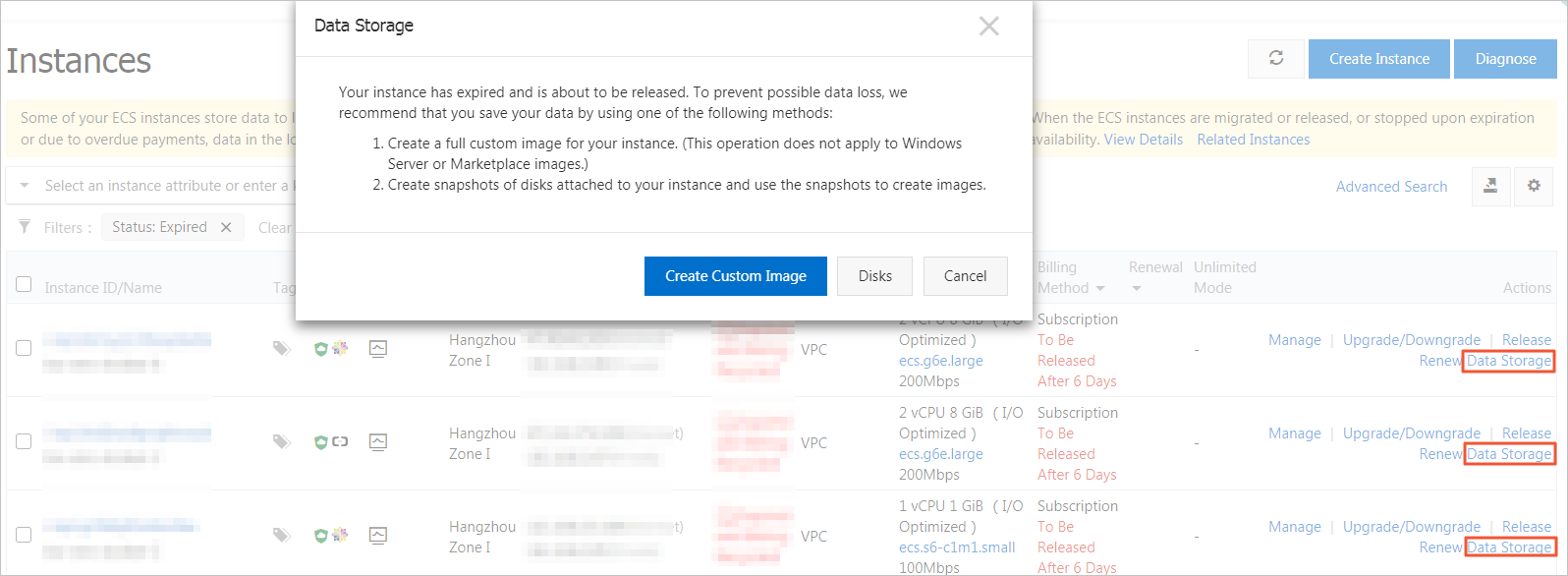Subscription is a billing method that allows you to use Elastic Compute Service (ECS) resources only after you pay for them. You can purchase subscription ECS instances to reserve resources for long-term use and save on bills. ECS provides larger savings for longer subscriptions. This topic describes the scenarios for which subscription ECS resources are suitable, impacts of subscription ECS instance expiration, and how to change the billing method of an ECS instance from subscription to pay-as-you-go.
Scenarios
If your business has the following characteristics, we recommend that you purchase subscription ECS resources:
Predictable usage period of resources
Consistent use of resources
Long-term use of resources
Examples: web services and database services that run 24/7.
Billable items
The following resources support the subscription billing method:
ECS instances, which include computing resources (vCPUs and memory)
Images that are used with subscription ECS instances
Cloud disks that re used with subscription ECS instances
Public bandwidth that is used with subscription ECS instances
Impacts of resource expiration
After a subscription instance expires, it may be stopped. You are notified to renew the instance. Renew the instance at your earliest convenience to ensure service continuity. If you have other questions, submit a ticket.
If the auto-renewal feature is not enabled for a subscription instance, the instance stops providing services at some point from 00:00:00 on the expiration date to 00:00:00 the next day.
You cannot enable the auto-renewal feature for an expired subscription instance.
The following table describes the resource states for an expired subscription instance for which the auto-renewal feature is not enabled.
Resource | Within 15 days after the instance expires | More than 15 days after the instance expires |
Computing resources (vCPUs and memory) | The computing resources (vCPUs and memory) of the instance are retained, but the instance stops providing services. Note After an instance is stopped, you cannot connect to the instance or access websites that are deployed on the instance, and service errors may occur. | The computing resources (vCPUs and memory) are released. |
Image | The image is unavailable. | The image is unavailable. |
Block storage device |
|
|
Public IP address |
|
|
If the auto-renewal feature is enabled for a subscription instance but the instance fails to renew, the instance stops providing services at some point from 00:00:00 on the 15th day after instance expiration to 00:00:00 on the 16th day after instance expiration.
The following table describes the resource states for an expired subscription instance for which the auto-renewal feature is enabled.
Resource | Within 15 days after the instance expires | 16 to 30 days after the instance expires | More than 30 days after the instance expires |
Computing resources (vCPUs and memory) | The computing resources (vCPUs and memory) are retained, and the instance works properly. Note You can start or stop an instance that works properly, and connect to the instance by using management terminals or other connection methods. | The computing resources (vCPUs and memory) of the instance are retained, but the instance stops providing services. Note After an instance is stopped, you cannot connect to the instance or access websites that are deployed on the instance, and service errors may occur. | The computing resources (vCPUs and memory) are released. |
Image | The image is available. | The image is unavailable. | The image is unavailable. |
Block storage device |
|
|
|
Public IP address |
|
|
|
After an instance expires, Data Storage is displayed in the Actions column corresponding to the instance on the Instances page. Before the instance is released, you can create a custom image from the instance or create snapshots for disks on the instance to back up disk data.
Change the billing method from subscription to pay-as-you-go
You can change the billing method of an instance from subscription to pay-as-you-go to recover some subscription costs and use the instance in a more flexible manner. For more information, see Change the billing method of an instance from subscription to pay-as-you-go.
Impacts of overdue payments
If you have overdue bills, existing subscription instances are not affected. However, you will be unable to perform activities that incur charges, including purchasing instances, upgrading instance configurations, or renewing resources. For more information, see Overdue payments.